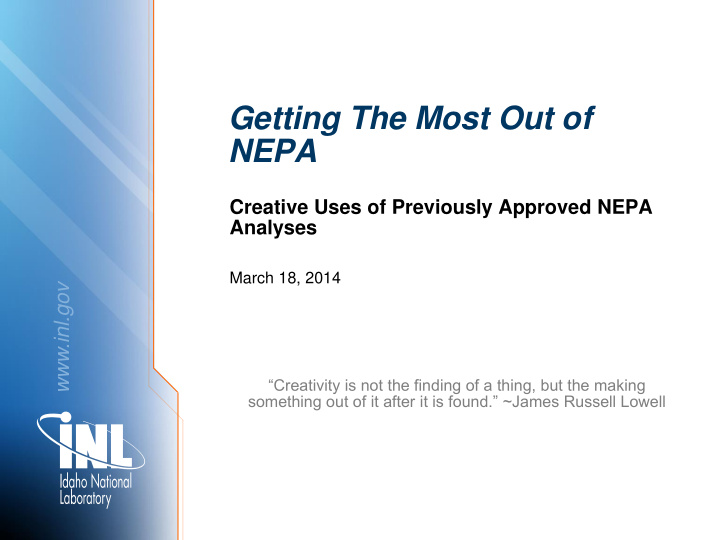



Getting The Most Out of NEPA Creative Uses of Previously Approved NEPA Analyses March 18, 2014 www.inl.gov “Creativity is not the finding of a thing, but the making something out of it after it is found.” ~James Russell Lowell
NEPA At INL • DOE-ID NEPA Compliance officer interprets NEPA decisions as a federal action that cannot be delegated. Approves all new activities at the CX level. • BEA has negotiated a two-tier environmental checklist process for many ‘routine’ activities. – 1 st Tier- a broad generic environmental checklist covering a categorically excluded action, such as R&D (B3.6). These documents receive a thorough technical review and are approved by DOE. – 2 nd Tier- a specific environmental checklist that is bounded by a 1 st tier EC. Approved by the contractor environmental organization. Receive periodic oversight by the DOE NEPA Compliance Officer.
Background • As a research lab, most INL activities are considered R&D • Relied heavily on CX B3.6 and a sometimes creative use of “conventional Laboratory operations” and the overarching checklist process • Revision of 10 CFR 1021 limited CX B3.6 to projects “generally” taking less than two years • DOE-ID requested greater involvement in environmental checklists and oversight of actions involving post irradiation examination and fuel (specifically stating these actions are not eligible for the 2 nd tier process, and in some cases, not B3.6).
Background Cont. • Around the same time, DOE removed certain environmental documents from the web • Reviewed those on web and requested those that had the potential to impact INL • In hindsight, the review was very beneficial because it provided an overview of the NEPA covering INL activities that proved valuable later (INL does not have a site-wide programmatic EIS;SNF EIS addresses core EM missions)
Why ask “Why?” • Late 2011, received checklist for installing a glovebox; reference and justification included CX B3.6 • Project pointed to numerous checklists that referenced B3.6 and argued the action was “routine” and, creatively, “conventional laboratory operations” • “Purpose and Need” needed clarification; big picture look raised a red flag for a CX • Started annoyingly asking “why” --Needed to continue processing surplus uranium • June 1996 FEIS for the Disposition of Surplus Highly Enriched Uranium (DOE/EIS-0240) and ROD (August 1996); 2007 SA Analysis to the EIS for Disposition of Surplus Highly Enriched Uranium (DOE/EIS-0240-SA1) and the August 2011 Amended ROD (EIS-0240); September 1994 Environmental Assessment for the Proposed Interim Storage of Enriched Uranium Above the Maximum Historical Storage Level at the Y-12 Plant Oak Ridge, Tennessee (DOE/EA-0929).
Getting “Creative” • Transfer of ZPPR Materials to NNSS – Material originally analyzed in an EA to be sent to LANL – LANL process transferred to NNSS in separate analysis – Used both NEPA documents to cover transportation from INL to NNSS without a supplement analysis • Terrapower and foreign research reactors – Fuel R&D and PIE analyzed in the PEIS for Expanded Civilian Nuclear Energy R&D – Irradiation in and transportation to and from foreign reactor was questionable – Was well within the quantities analyzed in the FRR EIS • High Performance Research Reactor Fuel Development – GTRI Reactor Conversion Program – Used infrastructure that was available at the time the Civilian Nuclear Energy R&D PEIS was completed and actions fit within those analyzed
NEPA Documents To Consider • EA and FONSI for Proposed Interim • Final Waste Management PEIS Storage of Enriched Uranium (DOE/EIS-0200-F) (DOE/EA-0929) – Every major DOE facility; emphasis on where to locate TSDs not comprehensive – 22 DOE sites; evaluated transportation, NEPA for specific sites (site-specific or processing, and interim storage project specific NEPA could be required) • EA and FONSI for Consolidation of • Programmatic SNF Management and Certain Materials and Machines for INEEL Environmental Restoration Nuclear Criticality Experiments and and Waste Management FEIS (Vol. Training (DOE/EA-1104) 1) (DOE/EIS-0203-F), ROD and – LANL, INL, Hanford, ORNL, SNL Amended ROD • WIPP Disposal Phase Final SEIS – Programmatic impacts of SNF (DOE/EIS-0026-S-2) transportation, storage, and characterization for the DOE Complex – WIPP, INL, ORNL, LANL, RFETP, Hanford, SRS — TRU Waste, long-term • Non-proliferation Foreign Research disposition including characterization and Reactor SNF FEIS (DOE/EIS-0218- transportation F) ROD and Amended RODS • NRC Generic EIS – SRS, INL, and 10 seaports • Transportation of commercial SNF
NEPA Documents to Consider Cont. • Storage and Disposition of Weapon- • PEIS for Accomplishing Expanded usable Fissile Materials FPEIS Civilian Nuclear Energy Research (DOE/EIS-0229) ROD, Amended and Development and Isotope ROD Production Missions in the U.S. including the FFTR – Pantex, SRS, ORNL, RFETP, INL, LANL, Hanford – ORNL, Hanford, INL, Commercial • Surplus Plutonium Disposition FEIS – Existing infrastructure for isotope production (medical, research, industrial), (DOE/EIS-0283) Pu-238 for NASA, Nuclear R&D for civilian – SRS, INL, Hanford, Pantex, LLNL, LANL, applications ORNL, Commercial Reactors • Various site-specific NEPA – Disposition up to 50 metric tons of surplus documents Pu
???Questions???
Recommend
More recommend